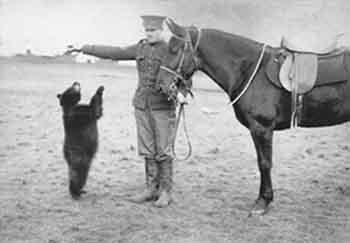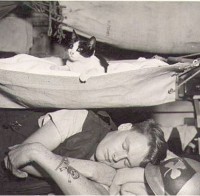
On Remembrance Day and during Veterans’ Week, we commemorate Canada’s military history and honour the soldiers, sailors and air force members who have bravely served our country, at home and abroad. This can also be a time to remember the numerous animals who have supported our Armed Forces on land, at sea, and in the air.
The army has often relied on the strength and endurance of large animals. Throughout World War I, thousands of horses carried troops and pulled heavy supplies and artillery. During the Second World War, elephants assisted with the construction of roads and bridges. Meanwhile, it was once thought that bears brought good luck to soldiers. The official mascot of the Canadian Army is Juno, a bear named after Juno Beach in Normandy, France (site of Canadian landing operations on D-Day: June 6, 1944). The well-loved children’s book character “Winnie the Pooh” was inspired by a female bear cub adopted by Lt. Harry Colebourn of the Fort Garry Horse, a cavalry regiment in Winnipeg. Lt. Colebourn brought Winnie to Valcartier, then on to England; prior to being housed at the London Zoo, Winnie was a pet at the Second Canadian Infantry Brigade Headquarters.
 Although the animals aboard our vessels have included a rabbit, a monkey, geese, an owl and a groundhog, Canadian naval ships have generally had feline mascots. Cats need minimal care, help control the rodent population, and boost morale by providing companionship to sailors who feel nervous or lonely.
Although the animals aboard our vessels have included a rabbit, a monkey, geese, an owl and a groundhog, Canadian naval ships have generally had feline mascots. Cats need minimal care, help control the rodent population, and boost morale by providing companionship to sailors who feel nervous or lonely.
Some animals have served in multiple environments. For instance, over the course of
the First and Second World Wars, approximately 300,000 pigeons flew with notes fastened to their legs, carried emergency messages onto planes and ships – and, making use of innovative technology for the time, occasionally wore small cameras to capture footage of opposing forces. In addition, the Canadian military has often trained dogs such as Belgian Malinois and German Shepherds to support search-and-rescue missions, locate explosives by scent, track and capture enemy fighters, and parachute from planes. To this day, dogs undergo extensive training in order to assist Canadian special operations forces.
Gord Gunn, a lawyer who observed horses being overworked and mistreated during
World War I, and Lieutenant-Colonel Richard Taylor, who served as President of the Ottawa Humane Society in the 1950s, were two of the individuals who created the Canadian Federation of Humane Societies. The Canadian military continues to make improvements and offer more humane treatment of animals, such as outfitting canine units with proper protective vests.
The Animals in War Memorial was unveiled in Ottawa on November 3, 2012, to honour the animals who serve and sacrifice on behalf of our country.
Article By:
Leigh Wood Landry, BA, BEd
Special Needs Inclusion & Parent Support Specialist Worker
Kingston Military Family Resource Centre
Resources
https://www.cbc.ca/news/politics/canadian-military-canine-units-1.5343096
https://en.wikipedia.org/wiki/Winnipeg_(bear)
https://www.greatwaralbum.ca/Great-War-Album/About-the-Great-War/Animals-in-war
https://prezi.com/dtdvahythank/canadian-federation-of-humane-societies/
https://www.veterans.gc.ca/eng/remembrance/classroom/tales-of-animals-in-war/animal_poster (English) and
https://www.veterans.gc.ca/fra/remembrance/classroom/tales-of-animals-in-war/animal_poster (French)
